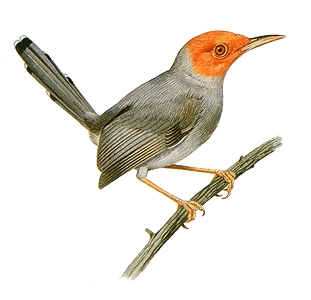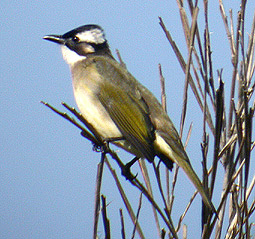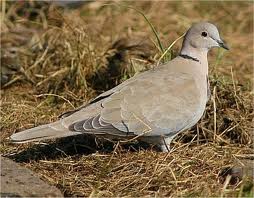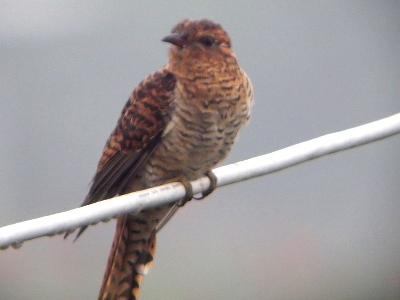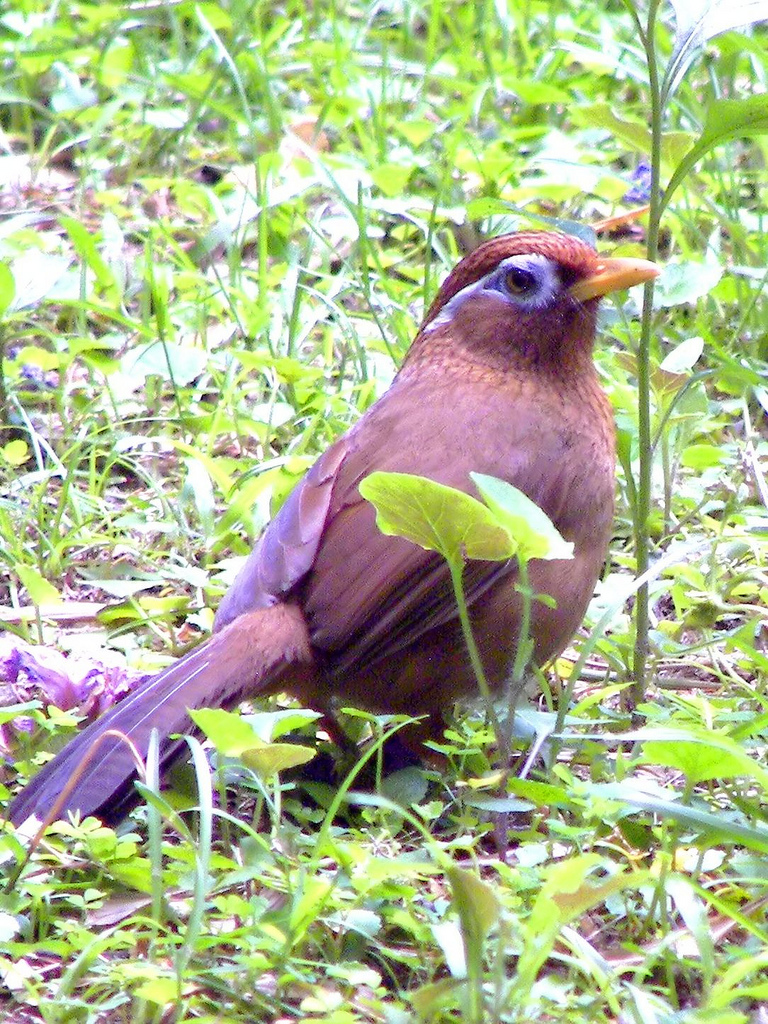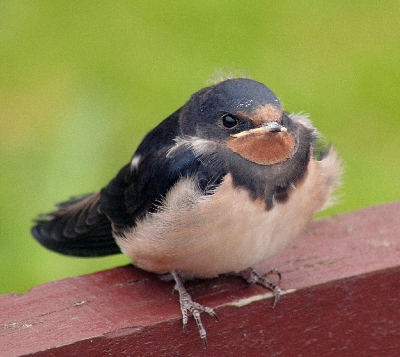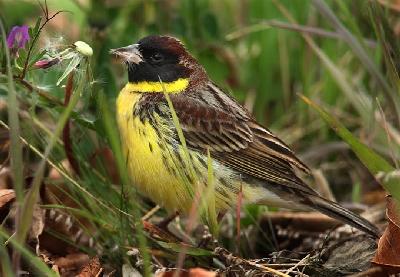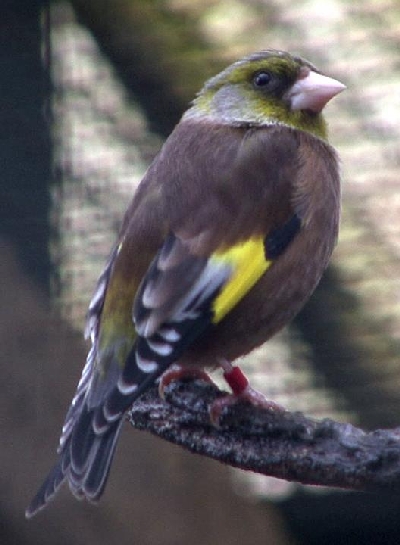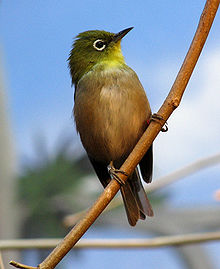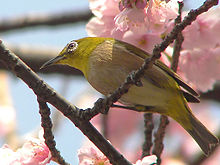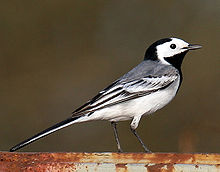Chivit Boca Sujo e mas Pastro-Pastro Macaísta
by Luis Felipe BaptistaClick on the SEARCH icon and enter his ID number (35568) to be taken to his personal page, PhD
"Hovering" the mouse pointer over a Portuguese or Macaísta word will often show its English translation.
At Professor Armando (Pinky) SilvaClick on the SEARCH icon and enter his ID number (6177) to be taken to his personal page's suggestion and encouragement I wrote an essay on common Hong Kong birds that I remembered from my childhood days with the main goal of preserving for posterity the Macaísta names for local birds passed down to us by our elders (see Revista Macau, Vol. 80(2) 1998). The positive and enthusiastic responses to the essay have been most gratifying. Some folks informed me that they had never heard those bird names before. Others told me that they were vaguely aware of some of those names and were delighted to see them assembled in one place. A few others, identified below, pointed out to me that I had omitted a few species. Still other friends updated me on the status of some of the taxa I wrote about.
In this second essay I write about the natural history of four species whose Macaísta names I was not aware of. I add two species, namely the Hwamei and Andorinho, and then discuss the status of some species based partly on my experiences during the Terceiro Encontro in Macau and a week's visit to Hong Kong, and partly on discussions and correspondence with knowledgeable friends who shared their reminiscences and experiences with me.
Jorge RemediosClick on the SEARCH icon and enter his ID number (10610) to be taken to his personal page brought Dennis (Chappie) RemediosClick on the SEARCH icon and enter his ID number (2859) to be taken to his personal page, a former Hong Kong magistrate now retired in Canada, to visit me at the California Academy of Sciences last December. Chappie had read my essay and found that I had omitted the Tailor-bird from my original list.
This is a tiny 4 inch bird with a long tail which is often held pointed vertically up towards the sky. It is basically green on the back with a reddish-brown crown, greyish-white throat and belly. The Chivit Boca Sujo is a very active species, continually flitting about and rarely stopping in one place for long except to sing or bathe or preen. I recall seeing one regularly singing from a pagoda tree in front of my aunt Carmen's home in number 2 Grampian Road, Kowloon. Its song is not particularly attractive, and consists of loud single short notes in a series (whit! whit! whit! whit! whit!) or a succession of paired notes (whitca! whitca! whitca! whitca!).
The name Tailor-bird reflects its habit of sewing leaves together to make a cradle and then building a nest within. To do this the female must actually puncture rows of small holes along the leaves' edges through which she works thread-like plant fibres or spider silk to sew the leaf edges together.
The female first drills holes 1/2 an inch from the leafmargin halfway down the leaf. It may then seek an old spider egg-cocoon, then unravel the cocoon-silk into a long strand in the same manner that Chinese artisans unravel silk from the cocoon of the silk-moth caterpillar. The chivit then threads the silk through the holes, fastening together the bottom halves of 2 or 3 large drooping leaves or the edges of one large leaf. Each end of the silken thread is then rolled into a ball to form a stud. Nest material consisting of plant fibres and vegetable down is then placed into the leafy cradle thus constructed. The nest cup is then lined with fine grass and perhaps some feathers. The clutch consists of 3 or 4 bluish-green eggs, blotched with light chocolate on the larger end.
Their nest-building is truly a feat to be admired and is a good example of tool-using in a bird. Primatologists have long believed that only humans and higher primates have the ability to use tools. The tailor bird clearly disproves that view.
The Macaísta name Chivit used for this feathered mite is misleading since it belongs to an entirely different family from the true chivits. True Chivits are members of the family Zosteropidae, native only to the Old World tropics and subtropics. Tailor-birds are members of the family Sylviidae or "Old World Warblers" with many relatives distributed throughout Europe and Asia, i.e. the zoogeographic region known as the Palearctic.
I puzzled a long time over the origin of the Tailor Bird's Macaísta name boca sujo. I believe I now have a plausible explanation for the origin of this odd epithet. During the Terceiro Encontro, Albert XavierClick on the SEARCH icon and enter his ID number (12516) to be taken to his personal page (now living in Queensland, Australia) presented me with a copy of "Birds of Hong Kong and South China" with the splendid illustrations by Karen Phillips, one of the authors of that opus. (Karen recently visited San Francisco and was introduced to me by some friends). The Tailor-bird's greyish-white throat feathers are black at the base. The text accompanying Karen's illustration of the Tailor Bird states that when this Chivit raises its throat feathers, notably when singing at high intensity, the dark feather bases are revealed. This would give one the impression of a bird with dark smudges on an otherwise immaculate face - unga pastro com boca ai qui sujo!
Tailor Birds are very abundant in Macau and Hong Kong. During my visit in March I heard their songs in almost all parklike situations in both cities. They can be very tame and on April 1 Artur Remedios and I visited the Jardim de Camões and I was surprised to see a Tailor Bird settle on a large dew-covered leaf on a shrub less than two meters from me. It then raised all its feathers, fluttered its wings and sent sprays of water droplets in all directions -- it was dew-bathing! Each dew-drop had captured a parcel of sunlight and through the binoculars one had an impression of a miniature fireworks display as the copious shiny drops of water burst forth in all directions towards the heavens. This is a cherished memory of Macau that has returned with me from the Encontro.
Buli-buli di MontanhaMountain Bulbul Chinese Bulbul
The Macaísta name for this species was again contributed by Chappie Remedios. The Cantonese name Paak Tau Yung, roughly translated as "white-headed old man", is very descriptive of the species which exhibits a large white patch on its crown. An active imagination has visualized him as an elder statesman of the avian world: but it is far from being old and decrepit. Indeed, the liquid notes of this loquacious species dominated the avian choruses all over Macau, downtown Kowloon, and all the wooded districts of Hong Kong from the botanical garden to the top of Victoria Peak. On a visit to the old fort on Lan Tau island I saw one of these Buli-bulis perch on an ancient cannon and belt out its songs. The name Buli-buli di Montanha is thus misleading since it is not confined to high altitudes as its epithet implies. They were seen at sea level all the way to Luggard Road at the peak tram terminal.
Chappie Remedios informed me that I had also left the "Ring Dove" out of my list of rolas in the first article. Other than the Rola Fogo (Streptopelia tranquebarica) which he was familiar with, the only other Ring Dove, members of the genus Streptopelia, found in Eurasia is Streptopelia decaocto. This species was originally restricted to Asia, but has recently spread on its own throughout Europe and England. There are no published records of this species for Hong Kong. Chappie informs me that although rare, hunters did shoot an occasional one in the New Territories. I never saw ring doves of any kind kept as pets when I was growing up ruling out observation of escaped captives. Chappie's observations must be of rare stragglers that at one time wandered into Kowloon.
My friend Paraskevas Candianidis, who remembers this bird from his boyhood in Greece, tells me that this dove's technical epithet "decaocto" is onomatopoeic and is translated as "eighteen" in Greek. The Macaísta epithet "cantadora" must refer to its melodious cooing. Like the Rola (Streptopelia chinensis) which has adapted so well to urban areas in Macau, Hong Kong and Kowloon, Rola Cantadoras are to be found close to human habitations throughout Europe. I had to fly to Chartres, France, two days after I returned from the Encontro trip, to deliver a keynote address at an international conference on "Bioacoustics". There were academics from all over the world lecturing on how fishes, insects, whales, porpoises, primates and birds talked to each other using sounds.
Chartres is a medieval city with a magnificent old Cathedral whose construction began in the eleventh century. My hotel was a fifteen minute walk from the conference hall, passing the cathedral and meandering through narrow roads often of cobblestones reminiscent of old Macau, and flanked by ancient moss-covered granitic walls shielding just as ancient homes. During my morning treks to the meeting place I thrilled to a continuous chorus of European birds emanating from the rooftops and treetops including the familiar Cooo-co-cooo(!) of Rola Cantadoras! These flute-like utterances recalled to me the lines from Alfred Lord Tennyson's beautiful poem "The Princess":
Mae-Pai-Filho Pastro ou Pastro di ChuvaMother-Father-Son bird or Rain bird Plaintive Cuckoo
During the Encontro, Francis OzorioClick on the SEARCH icon and enter his ID number (30290) to be taken to his personal page and Bosco CorreaClick on the SEARCH icon and enter his ID number (38206) to be taken to his personal page reminded me that I had omitted the Mae-Pai-Filho bird from my list of Macaísta bird names. This amusing name is onomatopoeic in origin: the bird's song may be rendered as sew-sew-sew-doodoo-doo-doo, interpreted by Macaístas as saying "Mae, Pai, Filho, tudo ja veng." Bosco knew the song very well but recalled that he could never identify the singer. Francis had once been informed of the bird's identity but could no longer remember. During the memorable reception at the Club de Recreio, Kowloon, hosted by Comendador A. de O. SalesClick on the SEARCH icon and enter his ID number (1820) to be taken to his personal page, Francis introduced me to Ruy BarrettoClick on the SEARCH icon and enter his ID number (36036) to be taken to his personal page, who currently practices law in Hong Kong and is an ardent bird watcher. It was Ruy who provided us with the bird's identity – the Plaintive Cuckoo!
The alternate name for this bird is Pastro di Chuva. Carlos NoronhaClick on the SEARCH icon and enter his ID number (29467) to be taken to his personal page pointed out to me that old Macaístas believed that its plaintive call Mae, Pai, Filho tudo ja Veng or Mae, Pai, Filho tudo ja morre is belted out just before it rains.
Ruy introduced Albert Xavier and me to Richard Lewthwaite who teaches English at the Chinese University in the New Territories and is very knowledgeable concerning Hong Kong birds. Richard guided us to woods in the New Territories where I finally recorded the song of this elusive avian chorister. We heard it sing many times but never saw the bird.
Just like its cousin the European Cuckoo (Cuculus canorus) [whose song is mimicked by a clarinet in Beethoven's 6th Symphony] this cuckoo is a brood parasite, i.e. it does not build its own nest but lays its eggs in the nests of Tailor Birds. Because the entrance to the Tailor Bird's nest is so tiny, it is unlikely that the much larger Cuckoo may actually lay directly into the nest. It is believed that the egg is laid on the ground and then placed into the nest with the bill.
This is an economically very important bird as much of its diet consists of insects, and notably of hairy caterpillars. It is thus one of the farmer's best friends.
Hwamei Garrulax conorus
This is a brown bird with a yellow bill and a conspicuous white patch which surrounds the eye and continues as a postocular streak. The Chinese name Hwamei means beautiful eyebrow. This same name has been adopted by English and Macaísta birders. The Hwamei belongs to the family of Laughing Thrushes or Timiliidae.
This bird is abundant in wooded areas with scrubby underbrush in both Hong Kong and Macau. It is one of the most beautiful songsters in the region, and like the Dominico was also pitted in fights in tea houses and large sums of money often wagered. The technique associated with the sport of Hwamei fighting is quite different from that with Dominicos. In Dominico fighting the owner that draws the shorter of two straws releases his bird into the cage belonging to the owner holding the longer straw. Hwameis are never let out of their "home" cage. Doors of Hwamei cages are fitted with a large fork-like device with long prongs almost as long as the cage itself. The prongs of the fork point down and alternate the bars of the cage door, i.e. each prong is flanked by 2 cage bars rendering all the gaps between bars equidistant. When these forks are removed, the remaining spaces between the cage bars are widened, wide enough for the Hwamei heads to pass through and peck at each other. My recollection of childhood observations of Hwamei fights is that the bouts were never as long as in Dominico: one competing Hwamei would yield and fly away from the cage door. The winner often followed with a victory song!
It was Johnny SequeiraClick on the SEARCH icon and enter his ID number (13388) to be taken to his personal page (one of the members of a very musical family) who introduced me to Hwameis. He made me a gift of one of these beautiful songsters, complete with cage and fork. Although I never fought birds or wagered on them, I often joined Johnny and Leslie Smirke on their visits to Kei Heung tea house where I enjoyed many hours of their singing.
During the Encontro, Francis Ozorio reported to me that he had heard a medley of these beautiful songsters in a wooded area on a visit to Taipa. I recall as a boy hearing beautiful choruses of these birds emanating from the scrubby hillsides behind Rosary Hill Priory, Stubbs Road, Hong Kong. Such choruses may still be heard on the slopes of Hong Kong peak.
The Hwamei is more often heard than seen in the wild as it tends to skulk about in scrubland. One bold individual sat on a fence in the Hong Kong botanical garden and poured forth copious melodies and I was fortunate enough to capture it with camera. The Cantonese community often keep them in elaborate cages which are taken to parks and hung on trees where these Carusos of the bird world would thrill their owners with their vocal gymnastics. Artur RemediosClick on the SEARCH icon and enter his ID number (10618) to be taken to his personal page and I saw such a bird in the Jardim de Camões during the Encontro. The bird's owner was very friendly, and not only did he allow me to photograph his pet, but also went on to lecture me on the merits of the other birds exhibited that day in the Jardim.
Andorinho Barn Swallow Hirundo rustica
Depending on whose classification one follows, there are 70 to 80 species of swallows in the world. The Barn Swallow has the largest distribution of them all: the Barn Swallow that we see in North America occurs also in Europe as well as in Hong Kong and Macau. It is no wonder then that the Macaísta name for this feathered gem is the same as the Portuguese name bestowed on it by our ancestors. It was probably a very familiar sight to the early Lusito immigrants.
Swallows are entirely insectivorous. They pursue and catch their prey on the wing, and to do so are equipped with long pointed wings like a delta jet plane. They are a marvel of aeronautical engineering, built to cruise across the sky at great speed. Swallows are also equipped with an enormous gape which helps them function like an aereal vacuum cleaner: with their bills wide open they waft flying insects into their gullets; they are tiny flying "whales" sucking in still tinier aereal plankton.
Swallows have short weak legs, not very suitable for walking. They rarely perch on the ground, and do so only to bathe or to collect mud to build their nests. The nest cup is a mixture of mud and straw and grass: they invented adobe long before humans did! Feathers line the nest cup in which 5 or 6 eggs are placed. Larger nests tend to contain more eggs and more young.
In this species the female builds the nests, males only rarely helping. During my boyhood days I noted that their nests were very common under the eaves of houses in Kowloon City where we bought victuals and where my brother Gaspar and I shopped almost daily for Tubifex worms (sah chung) and Daphnia (sol chih) to feed our aquarium fish. It was then that I noticed that old nests were repaired, relined and reused each year.
Barn Swallows sometimes nest in very unusual places. In 1935, a pair of these swallows was reported nesting on a moving train which ran from Lake Tagish to Lake Atlin, British Columbia, a distance of two miles. The observer, a Mr. Anderson, boarded the train at Atlin and noted the nest but not the birds. The swallows made their appearance, as soon as they arrived at Tagish, when they settled in the nest for the night. Nesting on this train must have been a learned tradition; nesting swallows were recorded there by several observers between 1914 and 1934. Barn Swallows have also been reported nesting on moving ferryboats. Small plastic colored bracelets placed around each swallow's ankles enabled scientists to recognize individuals. For example, with binoculars the investigator could see that Mary had a red bracelet, Charlie a blue one, etc. This also enabled scientists to study individual histories, and by so doing they discovered that although most birds in the population were monogamous a few were bigamous, i.e. some males had two wives.
The long forked tail is the salient character enabling us to distinguish this swallow from other species foraging in the sky. The outermost tail feathers in males are 16% longer than those in females and are very important in the male's display to attract a mate. The literature tells us that Barn Swallows return to Hong Kong about mid February each year to breed. Males arrive before females and select sites in which they wish to build a nest, or they identify sites from the previous year that they wish to reuse. The male flies in circles high up above the site and sings and displays his long-forked tail, the intensity of his song increasing when a potential mate arrives.
Investigators found that males with elongated tails were on average the first in the season to find mates. Males with shortened tails took four times as long to acquire females, and two never found consorts. Female swallows are impressed by long tails! Although females never sought extra-marital copulations they were free to accept or reject advances from males other than their mates by remaining perched or flying away. Incredibly, females accepted advances of males with artificially elongated tails more often than males with shortened or unmanipulated tail lengths. Females paired to males with longer tails also fathered (fledged) more young than males with shortened tails. These results support Darwin's theory of intersexual selection which predicts that females prefer males with extravagant male ornaments as mates, because such choices lead to earlier pairing and increased reproductive success by producing more progeny.
I sent a copy of the first essay on Macaísta birds to Dr. Kenneth Searle and Karen Phillips who are both retired in Portugal. Both my friends were active birders during their years of residence in Hong Kong and kindly wrote to update me on some changes in the status of the birds I had written about.
The Bico-chumbo (Lonchura atricapilla) is now a very rare bird in Hong Kong. It is normally seen in the fall and probably breeds in the colony no more. Because there are no longer paddy fields, the large flocks of Rola Fogo are no more to be encountered, although small numbers still pass through the colony as migrants. My friends write that the easiest place to see one of these beautiful doves today is in the large open waterfowl enclosure in Kowloon Park.
The large flocks of Ortolanas (Emberiza aureola) so common in my youth have also passed into memory due to changes in agricultural practices. In 1992 the highest count by birders was a flock of 30 of these buntings. The Pintassilgo (Carduelis sinica) is also very scarce in Hong Kong: their demise again attributed to changing agricultural practices. The Eurasian Starling (Sturnus vulgaris) is only a rare brumal visitor to the northern part of the New Territories. But then, it has never been common.
Fortunately, not all stories of the plight of Hong Kong birds are sad like those recounted above. The Pintassilgo, once common on the banyan trees lining Nathan Road, are no more to be heard; but happily, the Rola is still abundant and pours forth its flute-like coos with gusto. I saw Dominicos in many a garden, singing from trees, sitting on fences or foraging on lawns. The Chivit (Zosterops japonica) is also still abundant. I recorded songs from two individuals in downtown Nathan Road and from two others on Lantau Island. The songs from the two locations were distinctly different. The two birds I recorded on Lantau sang songs that were rather monotonous in structure and were replete with social calls, whereas those recorded in Kowloon sang songs much richer in variety of syllables. Much more study must be conducted on their song, but I appear to have discovered distinct dialects sung by the birds in each of the two recording sites. There is now also a second species of Chivit to be encountered in Hong Kong, namely Zosterops Erythropleurus, with chestnut sides, which visits in winter.
The Bico-chumbo (Lonchura striata) is now widespread and the most common of the three Bico-chumbo species in the area. I photographed a pair building their ball-shaped nest in the Hong Kong botanical gardens after the Encontro. The pair were surprisingly tame and were quite unperturbed when I approached within less than three meters of their nest. The spherical nest shell of grass stems was already completed and the pair continued to line the nest interior with plant materials as I watched from close by.
In 1995, birders discovered four pairs of Bate-cús (Motacilla alba) breeding in Kowloon. This report came some 40 years after my observations of the pair attending nestlings in the Homantin hills which I talked about in my first article. The Calhandra (Alauda galqula) is now known to breed in small numbers in Hong Kong. How lucky for the residents, for listening to a skylark singing high up in the sky is truly a spiritual experience. The Pastro Tira Sorte (Padda oryzivora) is to be seen in good numbers today in Kowloon Park and Victoria Park. A Chinese fortune teller was part of the entertainment during the Reception at Club Recreio mentioned above. He was quite friendly and cooperative and allowed me to photograph his plumed charges at work.
My childhood memories of this activity was always of each fortune teller with only one bird in a tiny cage. The fortune teller at Club Recreio had four different individuals: two were of the grey form typical of the wild ancestor, and two were snowy white, products of domestication. This fortune teller did not use a jar of numbered sticks which I wrote about in the first essay. The client was asked to select a fortune telling bird. The bird's cage door was opened and the mite went straight to a pile of envelopes and pulled one out. It was then rewarded with a paddy grain and returned to its cage. The fortune-teller then opened the envelope and read the "fortune" contained on a piece of paper concealed in the envelope. Atop the row of 4 small cages holding the diminutive feathered fortune tellers was a red plaque on which was written 4 large gold Chinese characters which may be phonetically rendered as Sun Liu Chan Po. This is roughly translated as "Fortunes told by divine birds."
During my visit to Hong Kong I was told that the book "Birds of Hong Kong and South China" has been translated into Chinese, thus increasing the readership of the book and the hobby of bird watching in the region, notably among the young folk. This is truly a significant development, for only through awareness of the beauties of wilderness surrounding us can humans be sensitized to the need to preserve as much of the wild as we can for posterity.
